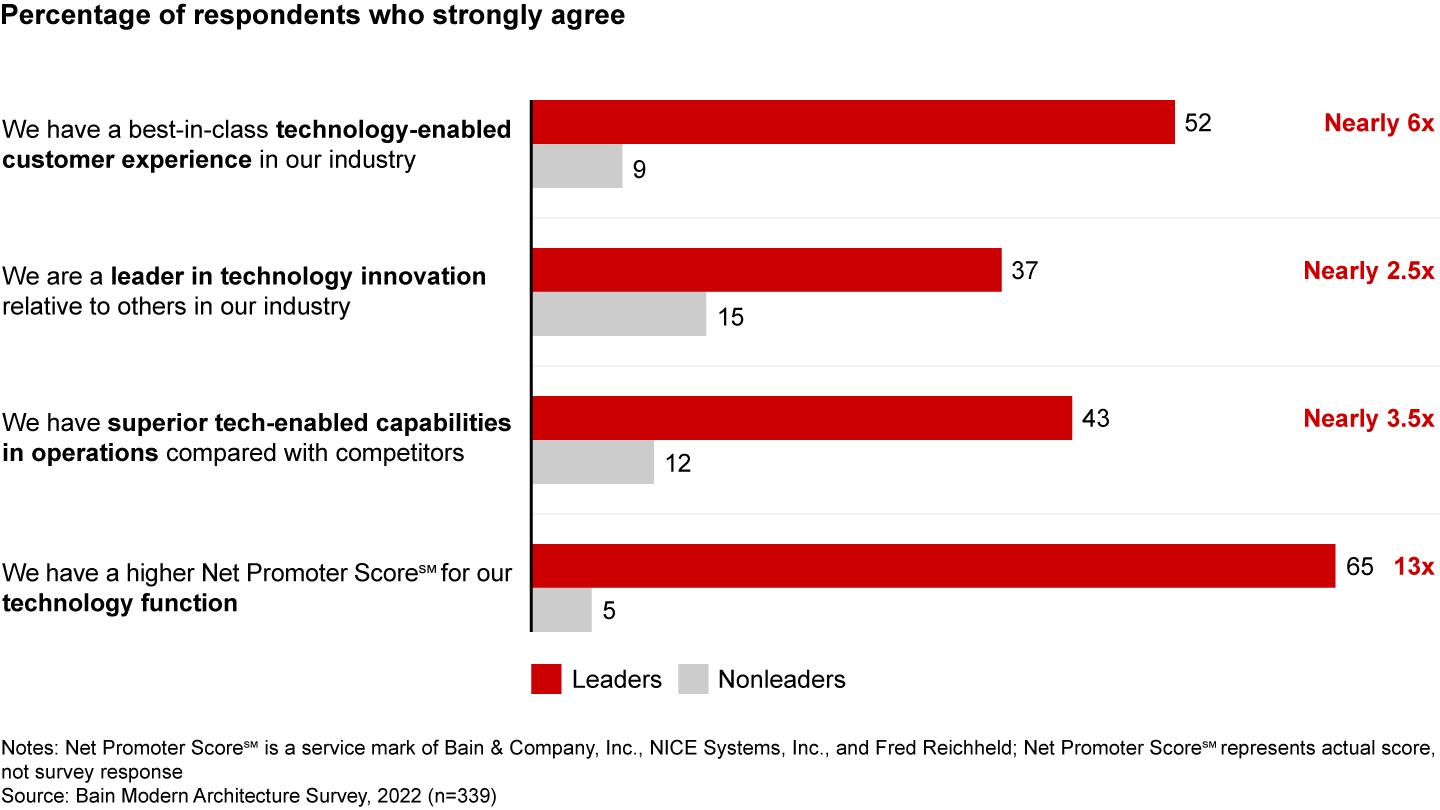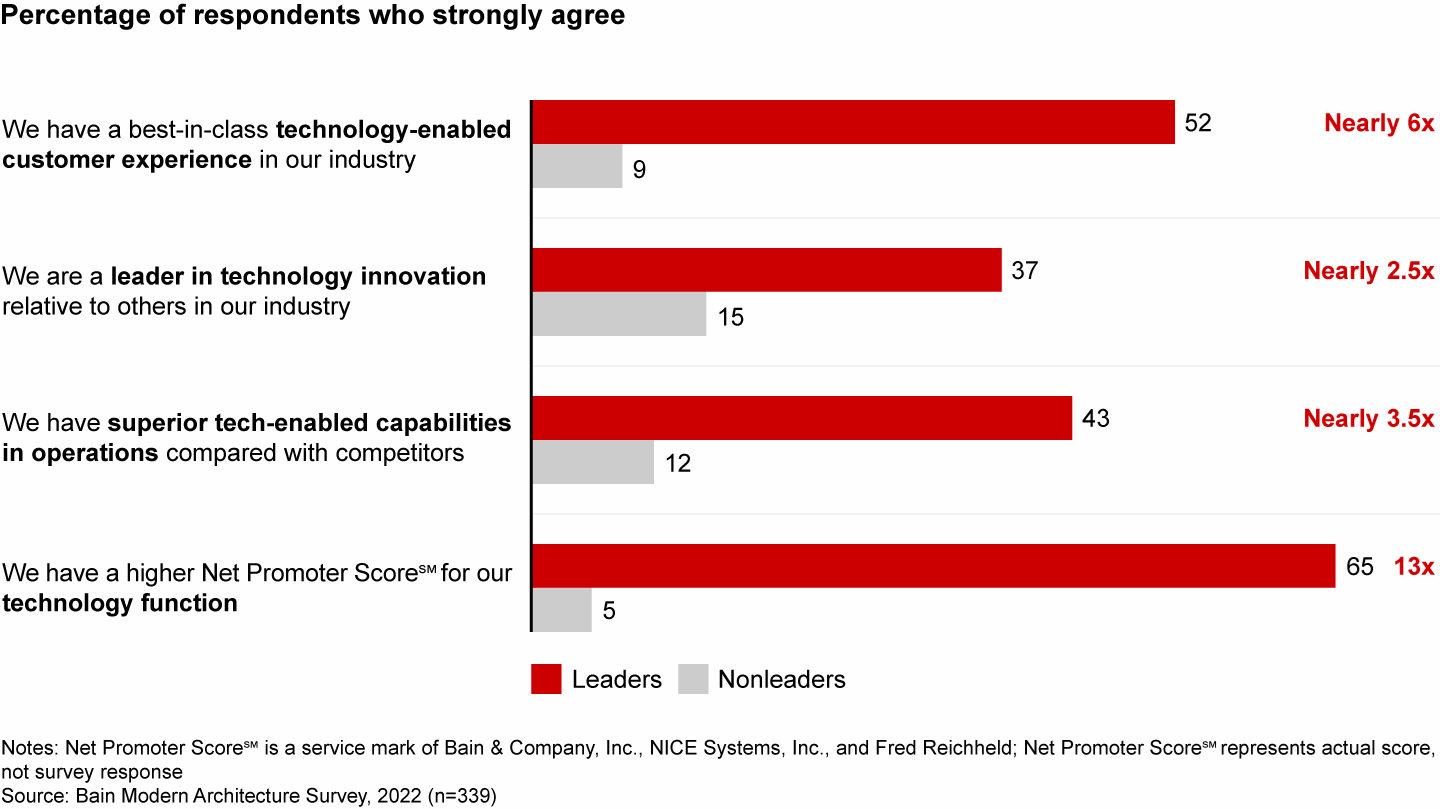Technology Report

At a Glance
- Companies with modern technology architectures outperform their competitors with better customer service, more efficient operations, and stronger customer advocacy.
- Modern architectures are Agile (able to adapt rapidly), real-time (putting data where it's needed), and intelligent (personalizing experiences using artificial intelligence and machine learning).
- Only 13% of executives say that they are getting the business value they expected from their spending on technology.
- Developing a better understanding of the connection between architecture and business value can help companies get a better return on those investments.
This article is part of Bain's 2023 Technology Report.
Companies with modern architectures (Agile, real-time, intelligent) outperform competitors by delivering a better customer experience, more efficient operations, and stronger customer advocacy (see Figure 1). They can scale quickly to capture the benefits of technology innovations, which helps them become market leaders.
But to capture those benefits, enterprise architecture needs to continuously evolve. This evolution happens gradually, taking a decade or more for technologies to move from cutting edge to mainstream. This stately pace may lull some tech executives into believing that they have ample time to put off complex change. And while moving quickly doesn’t guarantee success, we do see time and again that emerging leaders tend to adopt new technologies and architectural patterns early, which gives them time to climb the experience curve and achieve benefits well ahead of competitors.
Amazon’s adoption in the early 2000s of cloud-based service interfaces, which exposed data and functionality across the organization internally and externally, is a famous example of this. Those early investments continue to pay off for the retail leader, which saw sales grow by 25% annually between 2016 and 2022, compared with a market average of 6%. Even today, only 14% of companies are using similar modern, service-oriented technologies.
More recently, some neobanks that moved quickly to adopt a mobile-first customer experience saw growth rates of 52% a year between 2019 and 2022. One of these, Monzo, has a competitive cost position that allows it to serve twice as many customers per employee than traditional banks. Both outcomes are enabled by modern architectures based on microservices.


Getting architecture right
Despite this clear record of success, only about 13% of executives surveyed said that they are getting the business value they expect for the amount they spend on technology. Most of these companies are constrained by their legacy technology and, in some cases, by a lack of understanding about what modern architecture is.
- Agile: Modular, service-oriented architecture that enables quick changes.
- Real-time: Utilizing event-based architecture to make data available when and where it is needed.
- Intelligent: Embedded, mature, structured artificial intelligence (AI) and machine learning (ML) capabilities to ensure highly personalized customer and employee experiences.
Modern architecture supports digital capabilities across the enterprise (from customer experience and intelligent engagement to the core business and operational systems) with data, security, integration, and cloud architecture. It’s also critical for scaling emerging technology. For example, scaling AI applications across the enterprise requires access to data in a format that AI models can understand. This transformation of data requires modern data architecture and integration capabilities, connecting silos that might otherwise separate customer engagement and operational systems.
Commonwealth Bank of Australia (CBA) built a customer-engagement engine using AI and ML that enables its customer support function to suggest and personalize the best conversation to have with each customer in real time, whether they are in the branch, on the phone, online, or on a mobile device. Modern architecture enabled CBA to integrate data points from emergency sources and weather alert systems so that algorithms could monitor a situation in real time, which allowed the bank to support disaster recovery efforts during the Perth brush fires of 2021, offering personalized support to 80,000 clients. Those efforts paid off with a 6-point increase in its Net Promoter Score℠, which measures a customer’s likelihood of recommending CBA to peers.
While the benefits of modernization are clear, companies don’t need to be cutting edge everywhere, but they do need to apply the appropriate architectural patterns to the appropriate business processes. For example, Amazon Prime recently moved away from a microservices-based architecture for streaming media. In considering the additional complexity of service-oriented architectures, the company decided that a "modular monolith” would deliver most of the benefits for much less cost.
Companies that make a successful transition to modern enterprise architectures get a few things right.
- They have a clear point of view on how architecture helps create business value, whether it is cost reduction, transformation, asset reuse, or risk reduction.
- They modernize the capabilities that matter; not everything needs to be gold plated.
- They enable agility, providing flexibility for innovation while standardizing less differentiated capabilities (for more, read the Bain Brief “A Modern Enterprise Architecture Is Essential for Scaling Agile”).
- They build and own their architecture capabilities rather than relying on outsourced talent.
Enterprise technology architecture isn’t something that most business leaders have had to think about, but they can’t afford to ignore it any longer. Together with the leaders of the technology function, they need to ask whether they have the right architecture to help them succeed. Building a modern architecture requires ongoing experimentation and a commitment to investment over the long term. But without it and its support for real-time data integration, Agile development, and new AI capabilities, companies cannot expect to maintain a competitive advantage in today’s markets.